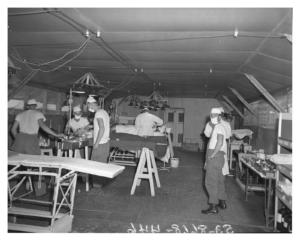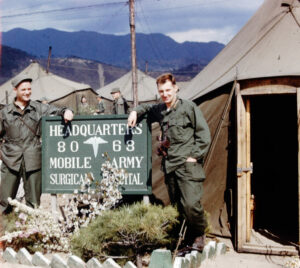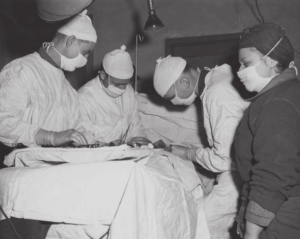The operating room of the 4077th Mobile Army Surgical Hospital became one of television’s most iconic sets, a place where comedy and tragedy intersected with surgical precision. For eleven seasons, viewers watched the talented surgeons of MAS*H save lives under impossible conditions, but behind the cameras lay fascinating secrets that even die-hard fans might not know. These hidden details reveal the extraordinary lengths the production team went to create authenticity, the real-life inspirations behind the medical procedures, and the unexpected challenges of filming in such a unique setting. Prepare to see the operating room in an entirely new light as we unveil ten remarkable secrets about the heart of the 4077th.
Real Surgical Consultants Were Always Present
The authenticity of MASH’s surgical scenes wasn’t accidental. The production employed actual surgeons as technical advisors who remained on set during every operating room scene. These medical professionals ensured that every incision, suture, and procedure appeared genuine, teaching the actors proper surgical techniques and terminology. The consultants didn’t just advise; they often performed the actual “surgeries” on camera using specially designed props and animal organs. This commitment to medical accuracy set MASH apart from other medical dramas and earned respect from real medical professionals who praised the show’s realistic portrayal of battlefield surgery.

The Operating Table Had a Hidden Secret
The iconic operating tables weren’t standard Hollywood props but specially designed pieces that concealed a remarkable secret. Beneath the tables, production crews installed elaborate systems of tubes, pumps, and reservoirs that controlled the flow of fake blood during surgical scenes. Operators could adjust blood flow in real-time, responding to the actors’ movements and the scene’s dramatic requirements. This hidden technology allowed for unprecedented realism in depicting traumatic injuries without requiring extensive post-production effects. The tables also featured removable sections that allowed camera operators to shoot from unusual angles, creating the intimate, claustrophobic feeling that defined the operating room scenes.

Actual Korean War Veterans Helped Design the Set
When production designer James Murakami created the operating room set, he didn’t rely solely on photographs and military records. He interviewed numerous Korean War veterans who had served in Mobile Army Surgical Hospitals, gathering firsthand accounts of what these facilities actually looked like, smelled like, and felt like. Veterans described the cramped conditions, the improvised equipment, and the organized chaos that characterized battlefield surgery. Murakami incorporated these details into every aspect of the set, from the placement of instrument trays to the type of lighting used. Some veterans visited the set during production and were moved to tears by how accurately it captured their wartime experiences.

The Surgical Instruments Were Authentic Period Pieces
The production team didn’t use modern surgical instruments painted to look old; they acquired actual 1950s-era medical equipment from military surplus stores and retired hospitals. These authentic instruments included forceps, scalpels, retractors, and clamps that had been used in real surgeries decades earlier. The prop department maintained these instruments meticulously, sterilizing them between uses even though they were only being used on fake patients. This attention to detail extended to every visible piece of equipment in the operating room, from the anesthesia machines to the overhead lights. Medical professionals who visited the set often remarked that they could have performed actual surgery with the equipment available.

The “Patients” Required Special Training
The actors who played wounded soldiers underwent extensive preparation to portray their injuries convincingly. Makeup artists spent hours creating realistic wounds using prosthetics, but the actors also received training on how to breathe, move, and react like someone in medical distress. They learned to simulate shock, blood loss, and various levels of consciousness while remaining completely still during “surgical” procedures. Some scenes required extras to hold uncomfortable positions for extended periods while covered in fake blood and prosthetics. The dedication of these background performers contributed significantly to the operating room’s authenticity, making viewers forget they were watching actors on a soundstage.
Temperature Control Was a Constant Battle
The operating room set was notoriously uncomfortable for the cast and crew. To create the appearance of the hot, humid Korean climate, production kept the soundstage temperature elevated, often exceeding eighty degrees. The actors wore heavy surgical gowns, masks, and gloves under bright lights that generated additional heat. Alan Alda and his co-stars would lose pounds of water weight during long operating room scenes, requiring frequent breaks for hydration. The sweat visible on the surgeons’ faces wasn’t makeup or glycerin spray; it was genuine perspiration from working in genuinely uncomfortable conditions. This physical discomfort actually enhanced performances, as the actors’ fatigue and frustration mirrored what real battlefield surgeons experienced.

Sound Design Created Invisible Atmosphere
The operating room’s soundscape was as carefully crafted as its visual elements. Sound designers created layers of ambient noise that viewers rarely consciously noticed but which dramatically enhanced the scenes’ realism. These included the rhythmic beeping of heart monitors, the hiss of anesthesia machines, the clinking of surgical instruments, and the muffled sounds of camp life outside. During particularly intense surgical scenes, sound engineers would gradually increase the volume and intensity of these background noises to build tension, then suddenly drop them to near-silence during critical moments. This sophisticated audio design made the operating room feel alive and authentic without distracting from the dialogue and drama.
The Lighting Told Its Own Story
Cinematographer William Jurgensen developed a distinctive lighting style for operating room scenes that evolved throughout the series. Early seasons used bright, even lighting that emphasized the comedy elements, but as the show matured, the lighting became more dramatic and shadowy. Jurgensen used practical lights—actual fixtures visible in the frame—to create realistic illumination while also crafting mood and atmosphere. The overhead surgical lights could be adjusted to create pools of brightness surrounded by darkness, visually isolating characters during emotional moments. This lighting approach influenced countless medical dramas that followed, establishing visual conventions still used today.
Improvisation Was Encouraged During Surgery
While the dramatic moments in operating room scenes were carefully scripted, director Gene Reynolds encouraged actors to improvise medical dialogue and banter during surgical procedures. The actors became so familiar with surgical terminology and procedures that they could ad-lib convincingly, creating natural-sounding conversations between surgeons. Many of the funniest and most memorable exchanges in the operating room were spontaneous creations by the cast. This improvisational freedom kept the scenes fresh and unpredictable, even for the actors themselves. The production would often shoot operating room scenes with multiple cameras running continuously, capturing these spontaneous moments that couldn’t be replicated in multiple takes.
The Set Became a Sacred Space
As the series progressed, the operating room set took on special significance for the cast and crew. Before filming particularly emotional scenes, the soundstage would fall silent as everyone prepared mentally for the work ahead. Cast members reported feeling a genuine sense of responsibility when performing these scenes, aware that real veterans and medical professionals would be watching. The set was maintained with unusual care, never used for other productions or purposes. When the series ended, several cast members requested pieces of the operating room set as mementos, recognizing that this space had been central to creating something truly meaningful. The operating table, surgical lights, and other key pieces were preserved and eventually donated to the Smithsonian Institution.
The Legacy Lives On
These ten secrets reveal that the 4077th’s operating room was far more than a television set; it was a carefully crafted environment where art, history, and genuine emotion intersected. The dedication to authenticity, from real surgical equipment to the uncomfortable heat, created a space where actors could deliver performances that honored the real people who served in Korea. Understanding these behind-the-scenes details deepens our appreciation for MAS*H’s achievement and explains why, decades later, these operating room scenes still feel immediate, real, and powerful.